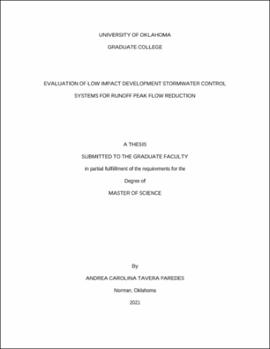| dc.description.abstract | Extreme precipitation events and increasing impervious surfaces, lead to increased runoff, surcharged storm sewer systems and consequent flooding as well as water quality deterioration, costing not only lives and habitat lost but millions of dollars in damage. Strategies to minimize the negative impacts of stormwater runoff are known as Low Impact Development (LID), which seek to reduce and prevent these impacts through site planning and techniques to mimic as close as possible, a site’s pre-developed hydrologic conditions, reducing the quantity of runoff and improving water quality. Such strategies can be evaluated with computer-based stormwater models, coupling a watershed’s existing stormwater system with LID techniques.
Undersized stormwater infrastructure is prone to flooding, as is the case for Sunnymeade in Oklahoma City, and the Pearl District in Tulsa. These two sites provide an opportunity to explore the potential of LID for peak flow reduction, using the InfoDrainage stormwater model. Results show that after LID implementation, improvements are representative in reducing storm water flooding within critical areas. Peak flow is considerably reduced in critical areas on the northwest and southwest areas of Sunnymeade, as well as on the north and south ends of Pearl District. Although flooding is still shown in the systems, this transferred onto the LID stormwater control systems, reducing the peak flow in the storm sewer systems from a 100-year storm event to less than a 25-year for Sunnymeade and a 1-year for Pearl District. Sensitivity analysis indicated that the 1-m topographic data, adjusted to urbanization, yields similar results in peak flows as to those of 1-ft survey data for Sunnymeade. Water quality results show a considerable contribution in percent reduction in pollutant loads for both study areas. Overall, LID systems are recommended to be installed in watersheds in Oklahoma given their remarkable potential at decreasing peak flows, with an added value of contributing to pollutant reduction. | en_US |

